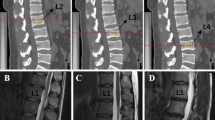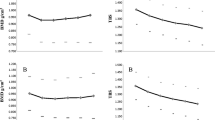Abstract
Summary
The distribution of bone tissue within the vertebra can modulate vertebral strength independently of average density and may change with age and disc degeneration. Our results show that the age-associated decrease in bone density is spatially non-uniform and associated with disc health, suggesting a mechanistic interplay between disc and vertebra.
Purpose
While the decline of bone mineral density (BMD) in the aging spine is well established, the extent to which age influences BMD distribution within the vertebra is less clear. Measures of regional BMD (rBMD) may improve predictions of vertebral strength and suggest how vertebrae might adapt with intervertebral disc degeneration. Thus, we aimed to assess how rBMD values were associated with age, sex, and disc height loss (DHL).
Methods
We measured rBMD in the L3 vertebra of 377 participants from the Framingham Heart Study (41–83 years, 181 M/196 F). Integral (Int.BMD) and trabecular BMD (Tb.BMD) were measured from QCT images. rBMD ratios (anterior/posterior, superior/mid-transverse, inferior/mid-transverse, and central/outer) were calculated from the centrum. A radiologist assigned a DHL severity score to adjacent intervertebral discs (L2–L3 and L3–L4).
Results
Int.BMD and Tb.BMD were both associated with age, though the decrease across age was greater in women (Int.BMD, − 2.6 mg/cm3 per year; Tb.BMD, − 2.6 mg/cm3 per year) than men (Int.BMD, − 0.5 mg/cm3 per year; Tb.BMD, − 1.2 mg/cm3 per year). The central/outer (− 0.027/decade) and superior/mid-transverse (− 0.018/decade) rBMD ratios were negatively associated with age, with similar trends in men and women. Higher Int.BMD or Tb.BMD was associated with increased odds of DHL after adjusting for age and sex. Low central/outer ratio and high anterior/poster and superior/mid-transverse ratios were also associated with increased odds of DHL.
Conclusions
Our results indicate that the distribution of bone within the L3 vertebra is different across age, but not between sexes, and is associated with disc degeneration.



Similar content being viewed by others
References
Riggs BL, Wahner HW, Dunn WL, Mazess RB, Offord KP, Melton LJ 3rd (1981) Differential changes in bone mineral density of the appendicular and axial skeleton with aging: relationship to spinal osteoporosis. J Clin Invest 67:328–335. https://doi.org/10.1172/JCI110039
Cooper C, Atkinson EJ, O’Fallon MW, Melton JL (2009) Incidence of clinically diagnosed vertebral fractures: a population-based study in Rochester, Minnesota, 1985-1989. J Bone Miner Res 7:221–227. https://doi.org/10.1002/jbmr.5650070214
Boden SD, Davis DO, Dina TS, Patronas NJ, Wiesel SW (1990) Abnormal magnetic-resonance scans of the lumbar spine in asymptomatic subjects. A prospective investigation. J Bone Joint Surg 72:403–408
Waxman R, Tennant A, Helliwell P (2000) A prospective follow-up study of low back pain in the community. Spine (Phila Pa 1976) 25:2085–2090
Thomsen JS, Ebbesen EN, Mosekilde LI (2002) Static histomorphometry of human iliac crest and vertebral trabecular bone: a comparative study. Bone 30:267–274
Ebbesen EN, Thomsen JS, Beck-Nielsen H, Nepper-Rasmussen HJ, Mosekilde L (1999) Age- and gender-related differences in vertebral bone mass, density, and strength. J Bone Miner Res 14:1394–1403. https://doi.org/10.1359/jbmr.1999.14.8.1394
Riggs BL, Melton LJ, Robb RA et al (2004) Population-based study of age and sex differences in bone volumetric density, size, geometry, and structure at different skeletal sites. J Bone Miner Res 19:1945–1954. https://doi.org/10.1359/jbmr.040916
Chen H, Shoumura S, Emura S, Bunai Y (2008) Regional variations of vertebral trabecular bone microstructure with age and gender. Osteoporos Int 19:1473–1483. https://doi.org/10.1007/s00198-008-0593-3
Christiansen BA, Kopperdahl DL, Kiel DP, Keaveny TM, Bouxsein ML (2011) Mechanical contributions of the cortical and trabecular compartments contribute to differences in age-related changes in vertebral body strength in men and women assessed by QCT-based finite element analysis. J Bone Miner Res 26:974–983. https://doi.org/10.1002/jbmr.287
Samelson EJ, Christiansen BA, Demissie S, Broe KE, Louie-Gao Q, Cupples LA, Roberts BJ, Manoharam R, D'Agostino J, Lang T, Kiel DP, Bouxsein ML (2012) QCT measures of bone strength at the thoracic and lumbar spine: the Framingham study. J Bone Miner Res 27:654–663. https://doi.org/10.1002/jbmr.1482
Wang Y, Owoc JS, Boyd SK, Videman T, Battié MC (2013) Regional variations in trabecular architecture of the lumbar vertebra: associations with age, disc degeneration and disc space narrowing. Bone 56:249–254. https://doi.org/10.1016/j.bone.2013.06.022
Grote HJ, Amling M, Vogel M, Hahn M, Pösl M, Delling G (1995) Intervertebral variation in trabecular microarchitecture throughout the normal spine in relation to age. Bone 16:301–308. https://doi.org/10.1016/8756-3282(94)00042-5
Davies KM, Stegman MR, Heaney RP, Recker RR (1996) Prevalence and severity of vertebral fracture: the Saunders county bone quality study. Osteoporos Int 6:160–165. https://doi.org/10.1007/BF01623941
Boos N, Weissbach S, Rohrbach H, Weiler C, Spratt KF, Nerlich AG (2002) Classification of age-related changes in lumbar intervertebral discs: 2002 Volvo award in basic science. Spine (Phila Pa 1976) 27:2631–2644. https://doi.org/10.1097/01.BRS.0000035304.27153.5B
Osti O, Vernon-Roberts B, Moore R, Fraser R (1992) Annular tears and disc degeneration in the lumbar spine. A post-mortem study of 135 discs. Bone Joint J 74–B:678–682
Cody DD, Goldstein SA, Flynn MJ, Brown EB (1991) Correlations between vertebral regional bone mineral density (rBMD) and whole bone fracture load. Spine (Phila Pa 1976) 16:146–154
Hussein AI, Jackman TM, Morgan SR, Barest GD, Morgan EF (2013) The intravertebral distribution of bone density: correspondence to intervertebral disc health and implications for vertebral strength. Osteoporos Int 24:3021–3030. https://doi.org/10.1007/s00198-013-2417-3
Livshits G, Ermakov S, Popham M, MacGregor AJ, Sambrook PN, Spector TD, Williams FMK (2010) Evidence that bone mineral density plays a role in degenerative disc disease: the UK Twin Spine study. Ann Rheum Dis 69:2102–2106. https://doi.org/10.1136/ard.2010.131441
Simpson EK, Parkinson IH, Manthey B, Fazzalari NL (2001) Intervertebral disc disorganization is related to trabecular bone architecture in the lumbar spine. J Bone Miner Res 16:681–687. https://doi.org/10.1359/jbmr.2001.16.4.681
Prescher A (1998) Anatomy and pathology of the aging spine. Eur J Radiol 27:181–195. https://doi.org/10.1016/S0720-048X(97)00165-4
Lane NE, Nevitt MC, Genant HK, Hochberg MC (1993) Reliability of new indices of radiographic osteoarthritis of the hand and hip and lumbar disc degeneration. J Rheumatol 20:1911–1918
Pollintine P, Dolan P, Tobias JH, Adams MA (2004) Intervertebral disc degeneration can lead to “stress-shielding” of the anterior vertebral body: a cause of osteoporotic vertebral fracture? Spine (Phila Pa 1976) 29:774–782
Adams MA, McNally DS, Dolan P (1996) “Stress” distributions inside intervertebral discs. Bone Joint J 78–B:965–972
Splansky GL, Corey D, Yang Q, Atwood LD, Cupples LA, Benjamin EJ, D'Agostino RB, Fox CS, Larson MG, Murabito JM, O'Donnell CJ, Vasan RS, Wolf PA, Levy D (2007) The third generation cohort of the National Heart, Lung, and Blood Institute’s Framingham Heart Study: design, recruitment, and initial examination. Am J Epidemiol 165:1328–1335. https://doi.org/10.1093/aje/kwm021
Yau MS, Demissie S, Zhou Y, Anderson DE, Lorbergs AL, Kiel DP, Allaire BT, Yang L, Cupples LA, Travison TG, Bouxsein ML, Karasik D, Samelson EJ (2016) Heritability of thoracic spine curvature and genetic correlations with other spine traits: the Framingham study. J Bone Miner Res 31:2077–2084. https://doi.org/10.1002/jbmr.2925
Hoffmann U, Massaro JM, Fox CS, Manders E, O’Donnell CJ (2008) Defining normal distributions of coronary artery calcium in women and men (from the Framingham Heart study). Am J Cardiol 102:1136–1141.e1. https://doi.org/10.1016/j.amjcard.2008.06.038
Canny J (1986) A computational approach to edge detection. IEEE Trans Pattern Anal Mach Intell PAMI-8:679–698. https://doi.org/10.1109/TPAMI.1986.4767851
Videman T, Battié MC, Ripatti S, Gill K, Manninen H, Kaprio J (2006) Determinants of the progression in lumbar degeneration. Spine (Phila Pa 1976) 31:671–678. https://doi.org/10.1097/01.brs.0000202558.86309.ea
Suri P, Hunter DJ, Rainville J, Guermazi A, Katz JN (2012) Quantitative assessment of abdominal aortic calcification and associations with lumbar intervertebral disc height loss: the Framingham study. Spine J 12:315–323. https://doi.org/10.1016/j.spinee.2012.03.033
Cheng XG, Nicholson PHF, Boonen S, Lowet G, Brys P, Aerssens J, van der Perre G, Dequeker J (1997) Prediction of vertebral strength in vitro by spinal bone densitometry and calcaneal ultrasound. J Bone Miner Res 12:1721–1728. https://doi.org/10.1359/jbmr.1997.12.10.1721
Gong H, Zhang M, Yeung HY, Qin L (2005) Regional variations in microstructural properties of vertebral trabeculae with aging. J Bone Miner Metab 23:174–180. https://doi.org/10.1007/s00774-004-0557-4
Samelson EJ, Hannan MT, Zhang Y, Genant HK, Felson DT, Kiel DP (2006) Incidence and risk factors for vertebral fracture in women and men: 25-year follow-up results from the population-based Framingham study. J Bone Miner Res 21:1207–1214. https://doi.org/10.1359/jbmr.060513
Bjarnason K, Hassager C, Svendsen OL, Stang H, Christiansen C (1996) Anteroposterior and lateral spinal DXA for the assessment of vertebral body strength: comparison with hip and forearm measurement. Osteoporos Int 6:37–42. https://doi.org/10.1007/BF01626536
Kanis J, Johnell O, Oden A et al (2002) Ten-year risk of osteoporotic fracture and the effect of risk factors on screening strategies. Bone 30:251–258. https://doi.org/10.1016/S8756-3282(01)00653-6
Bouxsein ML, Seeman E (2009) Quantifying the material and structural determinants of bone strength. Best Pract Res Clin Rheumatol 23:741–753. https://doi.org/10.1016/j.berh.2009.09.008
Keller T, Moeljanto E, Main J, Spengler D (1992) Distribution and orientation of bone in the human lumbar vertebral centrum. J Spinal Disord 5:60–74
Thomsen J, Ebbesen E, Mosekilde L (2002) Zone-dependent changes in human vertebral trabecular bone: clinical implications. Bone 30:664–669. https://doi.org/10.1016/S8756-3282(02)00686-5
Keller TS, Hansson TH, Abram AC et al (1989) Regional variations in the compressive properties of lumbar vertebral trabeculae: effects of disc degeneration. Spine (Phila Pa 1976) 14:1012–1019
Homminga J, Aquarius R, Bulsink VE, Jansen CTJ, Verdonschot N (2012) Can vertebral density changes be explained by intervertebral disc degeneration? Med Eng Phys 34:453–458. https://doi.org/10.1016/j.medengphy.2011.08.003
Whitaker M, Guo J, Kehoe T, Benson G (2012) Bisphosphonates for osteoporosis — where do we go from here? N Engl J Med 366:2048–2051. https://doi.org/10.1056/NEJMp1202619
Tenne M, McGuigan F, Besjakov J, Gerdhem P, Åkesson K (2013) Degenerative changes at the lumbar spine—implications for bone mineral density measurement in elderly women. Osteoporos Int 24:1419–1428. https://doi.org/10.1007/s00198-012-2048-0
Pfirrmann CA, Metzdorf A, Zanetti M et al (2001) Magnetic resonance classification of lumbar intervertebral disc degeneration. Spine (Phila Pa 1976) 26:1873–1878. https://doi.org/10.1097/00007632-200109010-00011
Modic MT, Steinberg PM, Ross JS, Masaryk TJ, Carter JR (1988) Degenerative disk disease: assessment of changes in vertebral body marrow with MR imaging. Radiology 166:193–199. https://doi.org/10.1148/radiology.166.1.3336678
Funding
This study received funding from the National Institute of Health (R01AR054620, R01AR053986, and R01AG041658) and support from the Framingham Heart Study (NIH/NHLBI Contract HHSN268201500001I).
Author information
Authors and Affiliations
Corresponding author
Ethics declarations
Conflict of interest
Ali Guermazi is the President of Boston Imaging Core Lab, LLC. He is a Consultant to MerckSerono, GE, TissueGene, OrthoTrophix, AstraZeneca, Pfizer, and Sanofi.
Ethics statement
All participants signed written informed consent before enrollment and examination. Our study was approved by the Institutional Review Board at Boston University Medical Center.
Electronic supplementary material
ESM 1
(DOCX 21 kb)
Rights and permissions
About this article
Cite this article
Kaiser, J., Allaire, B., Fein, P.M. et al. Correspondence between bone mineral density and intervertebral disc degeneration across age and sex. Arch Osteoporos 13, 123 (2018). https://doi.org/10.1007/s11657-018-0538-1
Received:
Accepted:
Published:
DOI: https://doi.org/10.1007/s11657-018-0538-1




